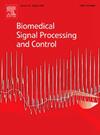基于自适应/定频经验小波变换和多域特征优化的认知负荷检测
IF 4.9
2区 医学
Q1 ENGINEERING, BIOMEDICAL
引用次数: 0
摘要
神经活动受到认知负荷的刺激,这对于理解大脑对精神紧张或压力诱导刺激的反应至关重要。本研究旨在探讨从脑电图信号的自适应和传统(节奏)子带中提取和分类特征以评估认知负荷的可行性。采用基于经验小波变换的自适应固定谱边界频率多分辨率分析方法,将每条持续时间为4秒的脑电通道数据分解为5个子带信号。在固定频率小波变换(FF-EWT)中,采用特定的边界频率设计滤波器组进行脑电节律提取。与FF-EWT相比,自适应频率EWT (AF-EWT)的频谱边界采用尺度空间方法自适应确定。下一步,从每个EEG节律或SBS中提取多域特征(时域、频域和非线性特征)。采用二元原子搜索优化(BASO)和二元平衡优化(BEO)算法降低特征空间维数,提高分类性能。我们进行了一项全面的研究,包括使用七种机器学习技术及其变体的特征、节奏/ sbs和整体特征分类。我们提出的方法将基于ff - ewt的多域特征与BASO和集成学习(EL)分类器相结合,在使用心算任务(MAT)、同时工作负荷(STEW)和心理负荷识别(MLR)脑电数据集检测认知负荷时,分类准确率分别达到97.9%、94.7%和99.1%。在节律和SBSs中,伽马节律似乎在分析各种认知任务中发挥了重要作用,并取得了最高的分类准确性。所提出的方法优于现有的最先进的技术在认知负荷检测的文献。本文章由计算机程序翻译,如有差异,请以英文原文为准。
Cognitive load detection using adaptive/fixed-frequency empirical wavelet transform and multi-domain feature optimization
Neuronal activity is stimulated by cognitive load, which is crucial for comprehending the brain’s response to mental strain or stress-inducing stimuli. This study aims to look into the feasibility of extracting and classifying features from adaptive and traditional (rhythms) subbands of electroencephalogram (EEG) signals to assess cognitive load. Each EEG channel data (4-second duration) was decomposed into five subband signals (SBSs) using the empirical wavelet transform (EWT)-based multi-resolution analysis with adaptive and fixed spectral boundary frequencies. In fixed-frequency EWT (FF-EWT), the filter bank was designed with specific boundary frequencies for EEG rhythm extraction. In contrast to FF-EWT, the spectral boundaries of adaptive frequency EWT (AF-EWT) were adaptively found using the scale-space method. In the next step, multi-domain features (time-domain, frequency-domain, and non-linear features) were extracted from each EEG rhythm or SBS. The feature space dimension was reduced using binary atom search optimization (BASO) and binary equilibrium optimization (BEO) algorithms for improved classification performance. We have carried out a comprehensive study that includes feature-wise, rhythm/SBS-wise, and overall feature classification using seven machine learning techniques and their variants. Our proposed method combining FF-EWT-based multi-domain features with BASO and ensemble learning (EL) classifiers achieved the highest classification accuracy of 97.9%, 94.7%, and 99.1% in detecting cognitive loads using the mental arithmetic task (MAT), simultaneous workload (STEW), and mental load recognition (MLR) EEG datasets, respectively. Among rhythms and SBSs, the gamma rhythm appeared to play a significant role in analyzing a variety of cognitive tasks and achieved the highest classification accuracy. The proposed method outperformed the existing state-of-the-art techniques in the literature for cognitive load detection.
求助全文
通过发布文献求助,成功后即可免费获取论文全文。
去求助
来源期刊

Biomedical Signal Processing and Control
工程技术-工程:生物医学
CiteScore
9.80
自引率
13.70%
发文量
822
审稿时长
4 months
期刊介绍:
Biomedical Signal Processing and Control aims to provide a cross-disciplinary international forum for the interchange of information on research in the measurement and analysis of signals and images in clinical medicine and the biological sciences. Emphasis is placed on contributions dealing with the practical, applications-led research on the use of methods and devices in clinical diagnosis, patient monitoring and management.
Biomedical Signal Processing and Control reflects the main areas in which these methods are being used and developed at the interface of both engineering and clinical science. The scope of the journal is defined to include relevant review papers, technical notes, short communications and letters. Tutorial papers and special issues will also be published.
 求助内容:
求助内容: 应助结果提醒方式:
应助结果提醒方式:


